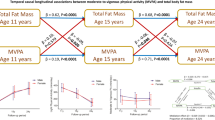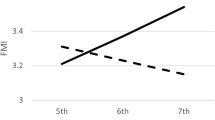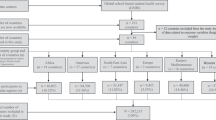Abstract
Objective:
(1) To assess the prevalence of childhood overweight (OW) and obesity in France; (2) to examine how physical activity and sedentary behaviour are involved in the association between socioeconomic status (SES) and OW, while taking into account total energy intake.
Design and subjects:
Representative sample of French children aged 3–14 years (n=1016) taken from the 1998–1999 cross-sectional French INCA (Enquête Individuelle et Nationale sur les Consommations Alimentaires) food consumption survey.
Measurements:
Weight and height, leisure-time physical activity (LTPA), sedentary behaviour (TV viewing and video-game use), and SES were reported by parents or children by answering questionnaires; total energy intake was assessed using a 7-day food record.
Results:
In total, 15.2% (95% CI: 13.0–17.6) of the children are OW (including obese), according to the IOTF (International Obesity Task Force) definition. OW is inversely associated with SES in children over 6 years of age. LTPA is negatively correlated to OW among the 3 to 5-year-old children only, whereas sedentary behaviour is positively related to OW in childhood and adolescence. From 6 years old on, SES is inversely associated with sedentary behaviour, which consequently may partly mediate the relationship between SES and OW.
Conclusion:
This study confirms the association between SES, sedentary behaviour and childhood OW in France. It was performed before the launching of the French Program of Nutrition and Health (PNNS) in 2001 and will be repeated in 2006. This will contribute to monitoring both childhood OW and its main determinants at the population scale.
This is a preview of subscription content, access via your institution
Access options
Subscribe to this journal
Receive 12 print issues and online access
$259.00 per year
only $21.58 per issue
Buy this article
- Purchase on Springer Link
- Instant access to full article PDF
Prices may be subject to local taxes which are calculated during checkout


Similar content being viewed by others
References
Andersen RE, Crespo CJ, Bartlett SJ, Cheskin LJ, Pratt M (1998). Relationship of physical activity and television watching with body weight and level of fatness among children: results from the Third National Health and Nutrition Examination Survey. JAMA 279, 938–942.
Basdevant A, Guy-Grand B (2004). Médecine de l'Obésité. Médecine-Sciences, Flammarion: Paris.
Batty GD, Leon DA (2002). Socio-economic position and coronary heart disease factors in children and young people. Evidence from UK epidemiological studies. Eur J Public Health 12, 263–272.
Berkey CS, Rockett HR, Field AE, Gillman MW, Frazier AL, Camargo CA et al. (2000). Activity, dietary intake, and weight changes in a longitudinal study of preadolescent and adolescent boys and girls. Pediatrics 105, E56 (9p.) Available at: www.pediatrics.org/cgi/content/full/105/4/e56.
Bellizzi MC, Dietz WH (1999). Workshop on childhood obesity: summary of the discussion. Am J Clin Nutr 70 (Suppl), S173–S175.
Brener ND, McManus T, Galuska DA, Lowry R, Wechsler H (2003). Reliability and validity of self-reported height and weight among high school students. J Adolesc Health 33, 141–142.
Cole TJ, Bellizzi MC, Flegal KM, Dietz WH (2000). Establishing a standard definition for child overweight and obesity worldwide: international survey. BMJ 320, 1240–1243.
Cradock AL, Wiecha JL, Peterson KE, Sobol AM, Colditz GA, Gortmaker SL (2004). Youth recall and TriTrac accelerometer estimates of physical activity levels. Med Sci Sports Exerc 36, 525–532.
Davies PS, Gregory J, White A (1995). Physical activity and body fatness in pre-school children. Int J Obes Relat Metab Disord 19, 6–10.
Deheeger M, Rolland-Cachera MF, Fontvieille AM (1997). Physical activity and body composition in 10 year old French children: linkages with nutritional intake? Int J Obes Relat Metab Disord 21, 372–379.
Deville JC (1991). A theory of quota surveys. Survey Methodol 17, 163–181.
Dietz WH, Gortmaker SL (1985). Do we fatten our children at the television set? Obesity and television viewing in children and adolescents. Pediatrics 75, 807–812.
Favier JC, Ireland J, Toque C, Feinberg M (1995). Répertoire général des aliments. Tables de composition (food composition tables). CIQUAL-REGAL 2nd edn. Tec and Doc Lavoisier: Paris.
Fontvieille AM, Kriska A, Ravussin E (1993). Decreased physical activity in Pima Indian compared with Caucasian children. Int J Obes Relat Metab Disord 17, 445–452.
Goran MI, Hunter G, Nagy TR, Johnson R (1997). Physical activity related energy expenditure and fat mass in young children. Int J Obes Relat Metab Disord 21, 171–178.
Gordon-Larsen P, McMurray RG, Popkin BM (2000). Determinants of adolescent physical activity and inactivity patterns. Pediatrics 105, E83(8p.) Available at: http://pediatrics.aappublications.org/cgi/reprint/105/6/e83.
Gortmaker SL, Must A, Sobol AM, Peterson K, Colditz GA, Dietz WH (1996). Television viewing as a cause of increasing obesity among children in the United States, 1986–1990. Arch Pediatr Adolesc Med 150, 356–362.
Gortmaker SL, Peterson K, Wiecha J, Sobol AM, Dixit S, Fox MK et al. (1999). Reducing obesity via a school-based interdisciplinary intervention among youth: planet health. Arch Pediatr Adolesc Med 153, 409–418.
Guillaume M, Lapidus L, Bjorntorp P, Lambert A (1997). Physical activity, obesity, and cardiovascular risk factors in children. The Belgian Luxembourg Child Study II. Obes Res 5, 549–556.
Hercberg S, Deheeger M, Preziosi P (1994). SU-VI-MAX. Portions alimentaires. Manuel photos pour l'estimation des quantités. Polytechnica: Paris.
Hernandez B, Gortmaker SL, Colditz GA, Peterson KE, Laird NM, Parra-Cabrera S (1999). Association of obesity with physical activity, television programs and other forms of video viewing among children in Mexico City. Int J Obes Relat Metab Disord 23, 845–854.
INSERM (2000). Obésité: depistage et prévention chez l'enfant. Expertise Collective. INSERM: Paris.
Janssen I, Katzmarzyk PT, Boyce WF, Vereecken C, Mulvihill C, Roberts C, et al., Health Behaviour in School-Aged Children Obesity Working Group (2005). Comparison of overweight and obesity prevalence in school-aged youth from 34 countries and their relationships with physical activity and dietary patterns. Obes Rev 6, 123–132.
Kettaneh A, Oppert JM, Heude B, Deschamps V, Borys JM, Lommez A et al. (2005). Changes in physical activity explain paradoxical relationship between baseline physical activity and adiposity changes in adolescent girls: the FLVS II study. Int J Obes Relat Metab Disord 29, 586–593.
Kimm SY, Barton BA, Obarzanek E, McMahon RP, Sabry ZI, Waclawiw MA et al. (2001). Racial divergence in adiposity during adolescence: The NHLBI Growth and Health Study. Pediatrics 107, E34(7p.) Available at: http://www.pediatrics.org/cgi/content/full/107/3/e34.
Kriska AM, Knowler WC, LaPorte RE, Drash AL, Wing RR, Blair SN et al. (1990). Development of questionnaire to examine relationship of physical activity and diabetes in Pima Indians. Diabetes care 13, 401–411.
Labeyrie C, Niel X (2003). L'état de santé des enfants de 5-6 ans dans les regions. Les disparités régionales appréhendées au travers des bilans de santé scolaire. DREES, Etudes et Résultats, no 250. DREES: Paris.
Labeyrie C, Niel X (2004). La santé des enfants scolarisés en CM2 à travers les enquêtes de santé scolaire en 2001-2002. DREES, Etudes et Résultats, no 313. DREES: Paris.
Lambert J, Agostoni C, Elmadfa I, Hulshof K, Krause E, Livingstone B et al. (2004). Dietary intake and nutritional status of children and adolescents in Europe. Br J Nutr 92 (Suppl 2), S147–S211.
Lobstein T, Frelut ML (2003). Prevalence of overweight among children in Europe. Obes Rev 4, 195–200.
Lobstein T, Baur L, Uauy R (2004). Obesity in children and young people: a crisis in public health. Obes Rev 5 (Suppl 1), S4–S104.
Maffeis C, Talamini G, Tato L (1998). Influence of diet, physical activity and parents' obesity on children's adiposity: a four-year longitudinal study. Int J Obes Relat Metab Disord 22, 758–764.
McMurray RG, Harrel JS, Levine AA, Gansky SA (1995). Childhood obesity elevates blood pressure and total cholesterol independent of physical activity. Int J Obes Relat Metab Disord 19, 881–886.
McMurray RG, Harrell JS, Deng S, Bradley CB, Cox LM, Bangdiwala SI (2000). The influence of physical activity, socioeconomic status, and ethnicity on the weight status of adolescents. Obes Res 8, 130–139.
Moore LL, Nguyen US, Rothman KJ, Cupples LA, Ellison RC (1995). Preschool physical activity level and change in body fatness in young children. The Framingham Children's Study. Am J Epidemiol 142, 982–988.
O'Loughlin J, Gray-Donald K, Paradis G, Meshefedjian G (2000). One- and two-year predictors of excess weight gain among elementary schoolchildren in multiethnic, low-income, inner-city neighborhoods. Am J Epidemiol 152, 739–746.
Rennie KL, Jebb SA, Wright A, Coward WA (2005). Secular trends in under-reporting in young people. Br J Nutr 93, 241–247.
Robinson TN (1999). Reducing children's television viewing to prevent obesity: a randomized controlled trial. JAMA 282, 1561–1567.
Rolland-Cachera MF, Cole TJ, Sempe M, Tichet J, Rossignol C et al. (1991). Body Mass Index variations: centiles from birth to 87 years. Eur J Clin Nutr 45, 13–21.
Rolland-Cachera MF, Castetbon K, Arnault N, Bellisle F, Romano MC, Lehingue Y et al. (2002). Body mass index in 7-9-y-old French children: frequency of obesity, overweight and thinness. Int J Obes Relat Metab Disord 26, 1610–1616.
Rowlands AV, Ingledew DK, Eston RG (2000). The effect of type of physical activity measure on the relationship between body fatness and habitual physical activity in children: a meta-analysis. Ann Hum Biol 27, 479–497.
Strauss RS (1999). Comparison of measured and self-reported weight and height in a cross-sectional sample of young adolescents. Int J Obes Relat Metab Disord 23, 904–908.
Tremblay MS, Willms JD (2003). Is the Canadian childhood obesity epidemic related to physical inactivity? Int J Obes Relat Metab Disord 27, 1100–1105.
Volatier JL (2000). Enquête INCA individuelle et nationale sur les Consommations Alimentaires. Tec and Doc Lavoisier: Paris.
Wagner A, Klein-Platat C, Arveiler D, Haan MC, Schlienger JL, Simon C (2004). Parent-child physical activity relationships in 12-year old French students do not depend on family socioeconomic status. Diab Metab 30, 359–366.
Wang Y, Monteiro C, Popkin BM (2002a). Trends of obesity and underweight in older children and adolescents in the United States, Brazil, China, and Russia. Am J Clin Nutr 75, 971–977.
Wang Z, Patterson CM, Hills AP (2002b). A comparison of self-reported and measured height, weight and BMI in Australian adolescents. Aust NZ J Public Health 26, 473–478.
Author information
Authors and Affiliations
Corresponding author
Additional information
Guarantors: S Lioret and J-L Volatier.
Contributors: SL analysed the data and wrote the paper. BM and M-AC were in charge of supervising the analysis and writing. J-LV contributed to the design of the survey and the data collection, supervised the analysis and helped to write the paper.
Rights and permissions
About this article
Cite this article
Lioret, S., Maire, B., Volatier, JL. et al. Child overweight in France and its relationship with physical activity, sedentary behaviour and socioeconomic status. Eur J Clin Nutr 61, 509–516 (2007). https://doi.org/10.1038/sj.ejcn.1602538
Received:
Revised:
Accepted:
Published:
Issue Date:
DOI: https://doi.org/10.1038/sj.ejcn.1602538
Keywords
This article is cited by
-
Socioeconomic inequalities in weight, height and body mass index from birth to 5 years
International Journal of Obesity (2018)
-
Systematic review of the relationships between sedentary behaviour and health indicators in the early years (0–4 years)
BMC Public Health (2017)
-
Systematic review of the relationships between physical activity and health indicators in the early years (0-4 years)
BMC Public Health (2017)
-
Socioeconomic Correlates of Sedentary Behavior in Adolescents: Systematic Review and Meta-Analysis
Sports Medicine (2017)
-
Why are primary school children overweight and obese? A cross sectional study undertaken in Kinondoni district, Dar-es-salaam
BMC Public Health (2015)



